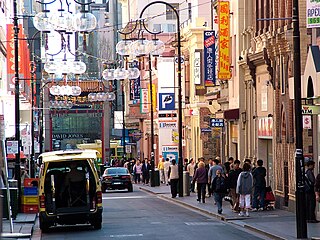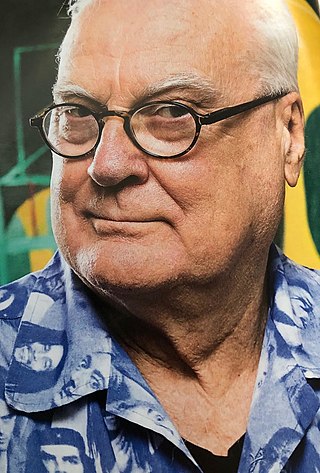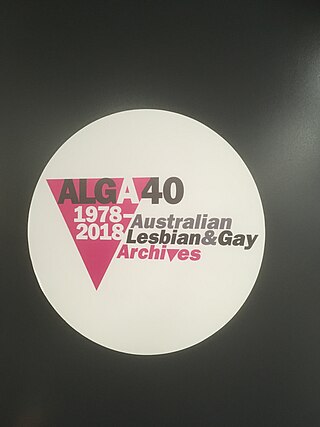
The National Gallery of Victoria, popularly known as the NGV, is an art museum in Melbourne, Victoria, Australia. Founded in 1861, it is Australia's oldest and most visited art museum.
The Melbourne Museum is a natural and cultural history museum located in the Carlton Gardens in Melbourne, Australia.

The Victorian gold rush was a period in the history of Victoria, Australia, approximately between 1851 and the late 1860s. It led to a period of extreme prosperity for the Australian colony and an influx of population growth and financial capital for Melbourne, which was dubbed "Marvellous Melbourne" as a result of the procurement of wealth.

State Library Victoria (SLV) is the state library of Victoria, Australia. Located in Melbourne, it was established in 1854 as the Melbourne Public Library, making it Australia's oldest public library and one of the first free libraries in the world. It is also Australia's busiest public library and, as of 2023, the third busiest library globally.

The Museum of Chinese in America is a museum in New York City which exhibits Chinese American history. It is a nonprofit 501(c)(3) education and cultural institution that presents the living history, heritage, culture, and diverse experiences of Chinese Americans through exhibitions, educational services and public programs. Much of its collection was damaged or destroyed in a fire in January 2020. After being closed for more than a year following the fire, the museum reopened to the public on July 15, 2021.

Richard Daintree CMG was a pioneering Australian geologist and photographer. In particular, Daintree was the first Government geologist for North Queensland discovering gold fields and coal seams for future exploitation. Daintree was a pioneer in the use of photography during field trips and his photographs formed the basis of Queensland's contribution to the Exhibition of Arts and Industry in 1871. Following the success of the display, he was appointed as Queensland's Agent-General in London in 1872 but was forced to resign in 1876 due to ill-health and malpractice by some of his staff although not Daintree himself. A number of features in North Queensland have been named after Daintree including the town of Daintree, Queensland, the Daintree National Park, the Daintree River, the Daintree Rainforest which has been nominated for the World Heritage List and the Daintree Reef.
The Western Australian Museum is a statutory authority within the Culture and the Arts Portfolio, established under the Museum Act 1969.
ACMI, formerly the Australian Centre for the Moving Image, is Australia's national museum of screen culture including film, television, videogames, digital culture and art. ACMI was established in 2002 and is based at Federation Square in Melbourne, Victoria.

Chinatown is an ethnic enclave in the central business district (CBD) of Melbourne, Victoria, Australia. Centred at the eastern end of Little Bourke Street, it extends between the corners of Swanston and Spring streets, and consists of numerous laneways, alleys and arcades. Established in the 1850s during the Victorian gold rush, it is notable for being the longest continuous ethnic Chinese settlement in the Western World and the oldest Chinatown in the Southern Hemisphere.

The Art Gallery of Ballarat is the oldest regional art gallery in Australia. It was established in 1884 as the Ballarat Fine Art Gallery by a company of interested citizens led by James Oddie. It initially rented out the first floor of the Ballarat Academy of Music; the current building on Lydiard Street North opened in 1890. The gallery was privately owned until financial insecurity led to the building and collection being handed over to the Ballarat City Council in 1977. In 2008, the gallery adopted its current name and became a free-entry venue. Louise Tegart is the gallery's current director.

Gareth Sansom is an Australian artist, painter, printmaker and collagist and winner of the 2008 John McCaughey Memorial Prize of $100,000.

The Australian Queer Archives (AQuA) is a community-based non-profit organisation committed to the collection, preservation and celebration of material reflecting the lives and experiences of lesbian, gay, bisexual, transgender and intersex LGBTI Australians. It is located in Melbourne. The Archives was established as an initiative of the 4th National Homosexual Conference, Sydney, August 1978, drawing on the previous work of founding President Graham Carbery. Since its establishment the collection has grown to over 200,000 items, constituting the largest and most significant collection of material relating to LGBT Australians and the largest collection of LGBT material in Australia, and the most prominent research centre for gay, lesbian, bisexual, trans and intersex history in Australia.

Chinatowns in Australia is a term used to describe major Chinese ethnic enclaves in Australia, especially those that claim to retain a strong Chinese cultural identity and a strong relationship with China. Chinatowns exist in most Australian states and territories, especially in the highly-populous and cosmopolitan capital cities but also in rural areas. Many large present-day Chinatowns in Australia have developed out of smaller historical Chinese settlements in Australia dating back to the 19th century. Chinese people first immigrated to Australia in large waves in the midst of the Australian gold rushes. Many of these people subsequently chose to return to China or were forcefully deported from Australia. The first known Chinese Australian was John Shying, who immigrated to Australia in 1818.
Frederick William Doolan Jnr, also known as Billy Doo, is an Australian Indigenous artist who lives in Townsville, Queensland but does most of his current artwork in Melbourne, Victoria.

Melbourne's Living Museum of the West is an ecomuseum and community social history museum in Melbourne's western suburb of Maribyrnong. It was established as part of Victoria's sesquicentenary in 1984, along with the Children's Museum and the Museum of Chinese Australian History.

The Golden Dragon Museum is situated in the city of Bendigo, Victoria, Australia. The museum is dedicated to the culture and history of Chinese Australians, particularly in the region. Built on the historical site of one of Bendigo's Chinatowns, the museum's precinct also includes Chinese Gardens and a temple to Kuan Yin. Through the museum accreditation program, it was the first accredited museum in Victoria.

Sun Loong, derived from the Cantonese pronunciation of "New Dragon", is an imperial parade dragon that was used in the Bendigo Easter parade from 1970 through 2019. It was believed to be the longest imperial parade dragon in the world, measuring approximately 100 metres (330 ft) long.
Ponch Hawkes is an Australian photographer whose work explores intergenerational relationships, queer identity and LGBTQI+ rights, the female body, masculinity, and women at work, capturing key moments in Australia's cultural and social histories.
Kate Beynon is an Australian contemporary artist based in Melbourne.
The Showgirl Magic Museum is a history and culture museum in the Chinatown neighborhood of San Francisco, California in the United States. The museum showcases on the 20th-century nightclub scene in Chinatown.














